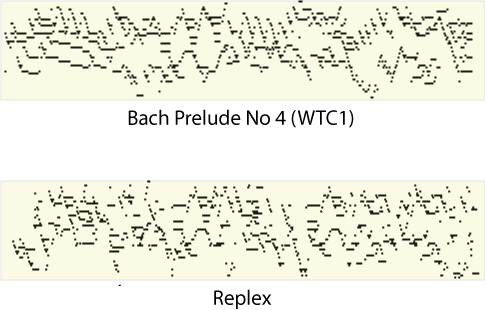
r e p l e x . . .
New work in the
Creative Systems Lab at the University of Sussex is exploring the
`replex', an informationally-defined entity with applications in
generative music. A replex is a machine-generated sequence which
`copies' the informational properties of some existing sequence. In
simple cases, replexes can be simple, syntactic variants. For example,
XXYZZ is a not very surprising replex of AABCC. In other cases, they
may show more differences. This has interesting implications where the
original sequence is a story, a poem or some music. In this situation,
a replex might show a combination of superficial differences and
structural commonalities, enabling it to `inherit' some of the
aesthetic properties of the original.
(Technical information on definitions and derivation methods is
available here.)
As an illustration, consider this replex derived from the opening bars
of of Beethoven's `Fur Elise'. Press Play to start playback. Press Stop
to finish.
 This longer replex is derived from Bach's prelude No. 4 in C# minor
(from WTC Book 1). The image on the right contrasts a note-grams for
this piece with one for the original.
This longer replex is derived from Bach's prelude No. 4 in C# minor
(from WTC Book 1). The image on the right contrasts a note-grams for
this piece with one for the original.
For comparison, the original composition sounds like this.
Comparing replexes with their sources, you may be able to hear
patterns from one cropping up in the other. Different types of music
produce different degrees of this. Music with more intricately
repetitive structure (e.g., Baroque piano music) will have more
elaborate informational properties. This tends to yield more organized
replexes and more obvious inheritance effects.
This replex is derived from the final bars of the 1st
movement of Stravinsky's Symphony of Psalms.
This replex
is derived from Bach's Fugue no. 5 from WTC2 (bars 13-63).
This is derived
from parts of Scarlatti's sonata in C minor (k11).
r h y m e s . . .
Replexes can also be derived from textual sequences such as
speeches, stories, jokes and poems. Consider the traditional
nursery rhyme `For want of a nail'.
For want of a nail the shoe was lost.
For want of a shoe the horse was lost.
For want of a horse the rider was lost.
For want of a rider the battle was lost.
For want of a battle the kingdom was lost
and all for the want of a horseshoe nail.
The prominent, repetitive structure here yields quite good replexes,
as illustrated by the text-box below. The text here is generated by an
applet that will generate a new replex each time you click anywhere in
the window. The replex may or may not differ from the original. Any
sequence is automatically a replex of itself. There's always a chance
that replex-generation will regenerate a perfect replica. In most
cases, there are a very large number of possible replexes, meaning
that re-generation of the original source is highly unlikely. (The
total number of replexes in a given case can be calculated by
measuring the branching factor of the relevant information
structure---see below).
As in the case of musical replexes, the greater the degree of
statistical structure in the source, the more likely it is the replex
will exhibit recognizable variations. Replexes derived from texts with
complex, interwoven patterns tend to be have more obvious organization.
This effect is illustrated with this replex-generator which uses
items 6-10 from the Ten Commandments.
If you skip down a few sections, you'll find a detachable applet which
you can use to generate your own text replexes.
h y p e r - r e p l e x e s . . .
For generative work with replexes, the simplest approach is to focus
on complete sources, i.e., whole pieces of music, complete stories
etc. This keeps things simple. We can give a straightforward account
of the thing we have derived a replex of. But it doesn't have
to work like this. We can derive information structures for part works
or combinations of works. The latter approach, in fact, is the easiest
way to construct a `multi-replex', i.e., a seguence derived from
several sources.
A more powerful method involves using an amalgamation of information
structures of several sources. Instances generated from amalgamated
information structures are `hyper-replexes'.
hyper replexes here...
f u z z y - r e p l e x e s . . .
Another interesting possibility is the `fuzzy replex'. This is a
sequence which embodies some statistical randomness or `noise'. There
are several possibilities for adding noise to replexes, including the
obvious scheme of simply randomizing symbol substitution process during
reconstitution. A more interesting idea involves adding noise just to
the lower level elements in a reconstitution, i.e., those elements
which have been derived from the more fine-grained components of the
structure. To generate this sort of object, we intervene in the
expansion process so as to ensure that below a certain depth, the
ordering of data is random. Sequences derived may then inherit
higher-level structural properties to a greater degree than lower-level
ones.
a p p l e t . . .
For experimentation with replexes we need software that can apply
sequence reduction to sequences and then perform reconstitution using
derived information structure.
The `replexer' applet (button below) provides this functionality for
text sequences. In the window that pops up you'll see some buttons on
the left, with small windows above and below. Next to this, there are
two long windows. To run the program type (or paste with CTRL-V) some
text into the upper-left window. Then press the Analyze button. The
system will apply sequence reduction to the text and display the
results in the form of an information structure (right window) and an
interpretation hierarchy (middle window). In the middle display, it is
possible to see how symbols in the initial sequence have been
relabeled, incrementally reducing the sequence to a single element.
To generate a replex of the source, press the Make button. A
reconstituted variant will then be constructed and displayed in
the bottom-left window.
c o n n e c t i o n s . . .

Replex analysis borrows from a variety of sources and also suggests
some new angles on old problems.
- Derivation of information structures for sequential data can be
viewed as a form of sequence analysis. This application has
become increasingly significant in recent years as a result of the
need for better interpretation of DNA data. On the assumption that
nature probably uses DNA in an informationally efficient manner, there
is the possibility of DNA analysis based on identification of
information structures.
- Derivation of information
structures can also be viewed as a
type of data
compression. Common compression methods (such as LZW compression) build
encodings for sequential data by constructing labels for
subsequences, in a similar fashion to sequence reduction. However
the encodings generated are not usually hierarchical or
informationally optimal.
- Music-generative methods often use Markov
chaining, a method which chains musical events together so as
to conform to transition probabilities observed in some database of
examples. The process is like sequence reduction in its
exploitation of sequential redundancy (i.e., `fuzzy repeats'). But,
being non-hierarchical, it has to be directed towards effects at a
specific level of detail. There is the possibility, then, of
adapting sequence reconstitution to provide a hierarchical
generalization of Markov-chaining.
- Where sequence reduction is applied to natural language
sequences, groupings often correspond to syntactic or semantic
categories. This is apparent with the `george1' and `simpsons1'
examples accessed from the applet. The information structure for the
latter (shown on the right) contains constituents corresponding to all
the main syntactic categories evidenced in the data, including proper
names, nouns, verbs, verb phrases and noun phrases. There is the
possibility of adapting sequence reduction as an informational form of
grammatical inference.
- Where musical compositions are used as data for
(information-structure) analysis, the process can also be viewed as
learning, with the supplied data then being seen as `examples'.
On this view, an interesting aspect of sequence reduction is its
ability to perform `one shot learning', i.e., to produce output on
the basis of a single example.
- Traditionally, there have been two main areas of information
theory. The Shannon version of the theory is based on the idea
that the amount of information in a signal or event is the degree
to which it reduces
uncertainty in an observer. The Kolmogorov version of the theory (
Algorithmic information theory) is based on the idea that the
amount of information in a structured object is the size of its
smallest effective description. However, it is only Shannon
information which can be measured in general. In calculating the
information hiearchy of a sequence, we are evaluating informational
properties of a structured object but doing so using Shannon's
approach. Alternatively, we might see it as calculating a type of
Kolmogorov complexity where `the computer' is equated with the
functionality of symbol-rewriting.
- The Kolmogorov connection also connects sequence reduction
with inference. Kolmogorov's idea (that the amount of complexity in
some data is the size of its smallest generative description) is
closely related to Occam's
Razor, the principle that the best model for some data is also
the simplest that can be devised. This in turn is related to the
idea that it is the simplest model which generates the best
inductive inferences and generalizations. A well-known incarnation
of this is Rissanen's
Minimum Description Length (MDL) principle, which states that
the best model of some data is the one that provides the largest
compression of the data. Rissanen's approach is particularly
relevant since it specifically relates to sequential encodings
(hence the `length' in the title). However, it does not dictate the
way in which encodings are derived and it does not naturally
accommodate hierarchical reduction. Nevertheless, there is a a
close relationship and there may be the possibility of treating
sequence reduction as an MDL variant which is `automatic' (i.e.,
code-inventing) and hierarchical.
c o p y r i g h t . . .
As the examples on this page show, replex-derivation can produce
variations and combinations of existing musical and textual
sequences. But where the original sequences are valued artefacts
(such as Bach preludes) there is the problem of deciding who has
copyright on the generated example. In an informational sense, any
replex is identical to its source. So where there is a
single source, this would seem to dictate that the the copyright
for a replex should rest with whoever has copyright on the source.
But this goes against the convention that copyright does not extend
to artefacts which vary an original in any kind of substantial way.
And it doesn't work with multi-replexes. Perhaps the best that can
be said is that replex analysis challenges conventions on
copyright.
m o r e . . .
For further information, examples, software, sources etc.,
contact Chris Thornton at sussex.ac.uk (using initial.lastname).
Feedback and comments welcome.
www.christhornton.eu
 This longer replex is derived from Bach's prelude No. 4 in C# minor
(from WTC Book 1). The image on the right contrasts a note-grams for
this piece with one for the original.
This longer replex is derived from Bach's prelude No. 4 in C# minor
(from WTC Book 1). The image on the right contrasts a note-grams for
this piece with one for the original.
 This longer replex is derived from Bach's prelude No. 4 in C# minor
(from WTC Book 1). The image on the right contrasts a note-grams for
this piece with one for the original.
This longer replex is derived from Bach's prelude No. 4 in C# minor
(from WTC Book 1). The image on the right contrasts a note-grams for
this piece with one for the original.